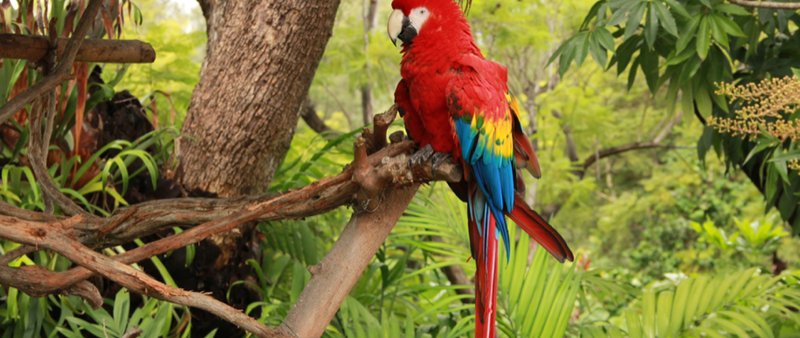
Let’s dive into the world of parrots and explore how they adapt to their habitats. We’ll look at various aspects—including their physical features, social behaviors, and even their diets—that make them masters of adaptation. Understanding these traits not only gives us insight into these beautiful birds but also highlights the intricate balance of nature and the importance of preserving their environments.
Physical Adaptations of Parrots
Parrots are built for life in the trees. Their distinctive strong, curved beaks are perfect for cracking open nuts and seeds. This shape isn’t just for show; it’s an evolutionary trait that allows them to access high-energy food sources that many other birds can’t reach. In addition to their beaks, their zygodactyl feet—where two toes point forward and two backward—give them a solid grip on branches. This feature makes it easier for them to climb and navigate the sometimes tricky terrain of their jungle homes.
You might be wondering how color plays into their survival. The bright hues of many parrots, like the vibrant green of the Amazon parrot or the striking blue of the hyacinth macaw, often serve as camouflage among the leaves and flowers. This helps them avoid predators while blending seamlessly into their environment. It’s nature’s way of giving them an upper hand, helping them stay safe while they explore their surroundings.
Behavioral Adaptations of Parrots
Parrots are social creatures. They often live in flocks, which helps them protect each other from predators. By working together, they can keep a lookout while foraging for food. You might think of it like a group of friends keeping an eye out for each other at a concert—everyone’s there to have fun, but they also look out for one another’s safety.
Another interesting behavioral adaptation is their vocal ability. Parrots are known for their ability to mimic sounds, including human speech. This talent isn’t just for entertainment; it helps them communicate with each other in their natural habitats. Different calls can signal danger or alert others about food sources. Think of it as their version of texting, where different sounds carry important messages among flock members.
Dietary Adaptations of Parrots
Diet plays a huge role in how parrots adapt to their surroundings. Most parrots primarily eat seeds, nuts, and fruits, which are abundant in tropical environments. Their strong beaks make it easy to crack open hard shells, while their agility helps them reach food in high branches. But here’s the thing—parrots are also opportunistic feeders. This means they don’t stick strictly to one type of food.
If certain fruits are scarce, they’ll switch up their diet and eat flowers, bark, or even insects. This flexibility is crucial for their survival. Parrots have learned to take advantage of whatever is available, making them less dependent on a single food source. Just like how we might spice up our meals when we can’t find our favorite ingredients, they adapt their tastes to what’s on the menu in their environment.
Habitat and Environmental Adaptations
Parrots are incredibly versatile when it comes to their habitats. While many people picture them in tropical rainforests, they can also be found in savannas, woodlands, and even arid regions. This adaptability is key to their survival in changing climates. For instance, some parrot species have been known to migrate if their environment becomes inhospitable.
Let me explain a bit more. When there’s a drought or a change in the ecosystem, parrots might fly to new locations where food and water are plentiful. This migratory behavior helps ensure that they can continue to thrive. It’s like a survival instinct that allows them to adapt to their challenges rather than sticking to an area that no longer supports them.
Intelligent Adaptations of Parrots
Another fascinating aspect of parrots is their intelligence. They are among the smartest birds in the animal kingdom. This intelligence allows them to solve problems and adapt to various challenges in their environment. For example, they can use tools to help them access food, such as using sticks to poke into crevices or even dropping hard objects onto the ground to crack them open.
You might be surprised to learn that their problem-solving abilities also come into play in social situations. Parrots often engage in play, which isn’t just for fun; it’s a way for them to learn and adapt their behaviors. By interacting with their flock and even mimicking human behavior, they can develop new skills that help them in the wild. In essence, their intelligence is another tool that helps them navigate their world effectively.
Conservation and Its Impact on Parrot Adaptation
As we learn more about how parrots adapt to their environments, it’s crucial to consider the impact of human activity on their habitats. Deforestation, climate change, and illegal pet trade pose significant threats to their populations. When environments change rapidly due to human actions, parrots and other wildlife face challenges in finding food and shelter.
Conservation efforts play a vital role in protecting these incredible birds. By preserving their natural habitats and reducing human impact, we give parrots a fighting chance to adapt and thrive. Organizations around the world are working to create protected areas and raise awareness about the importance of wildlife conservation. By supporting these efforts, we can help ensure that future generations will continue to marvel at the beauty and adaptability of parrots.
Closing thoughts: Parrots are remarkable examples of nature’s creativity and resilience. From their physical and behavioral adaptations to their intelligent problem-solving skills, these birds have evolved to thrive in diverse environments. By understanding how they adapt, we not only appreciate their beauty but also recognize the importance of protecting their habitats for years to come. Ultimately, preserving their environment is essential for the survival of these vibrant creatures. So next time you hear a parrot’s cheerful squawk or catch a glimpse of them soaring through the trees, remember that every flutter and call is a testament to the wonders of adaptation in nature.
